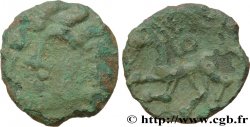v51_0130 - BEOTIA - TEBA Statère
MONNAIES 51 (2011)
Начальная цена : 750.00 €
Назначить цену : 1 200.00 €
непроданный лот
Начальная цена : 750.00 €
Назначить цену : 1 200.00 €
непроданный лот
Тип Statère
Дата: c. 425-400 AC.
Монетный двор / Город: Béotie, Thèbes
Металл: silver
Диаметр: 23 mm
Ориентация осей монеты: 3 h.
Вес: 12,34 g.
Редкость: R2
Emission: 2e
Комментарии о состоянии
Exemplaire sur un flan épais, ovale et irrégulier, décentré au droit. Joli revers avec un carré creux bien marqué, en relief. Patine de collection ancienne avec des reflets mordorés
Ссылки в каталоге: :
Происхождение:
Cet exemplaire provient de la vente Bourgey du 5 mai 1987, n° 40
Лицевая сторона
Аверс: легенда: ANÉPIGRAPHE.
Аверс: описание: Bouclier béotien ; les restes d’une massue posée à gauche, timbrée sur le bouclier.
Обратная сторона
Реверс: Описание: Cratère (diota) ; le tout dans les restes d’un carré creux.
Реверс: легенда: Q-E
Реверс: перевод: (Thèbes).
Комментарий
Ce type avec les deux premières lettres de l’ethnique serait frappé entre la chute d’Athènes et la paix du grand Roi. Notre type est difficilement identifiable. Nous n’avons pas de symbole dans le champ du revers, en dehors d’une petite cassure de coin, le long de la poignée gauche du cratère. En revanche, les restes de la massue timbrée sur le bouclier ne laisse planer aucun doute sur l’identification du type qui semble beaucoup plus rare que ne le laissent supposer les ouvrages généraux. Au droit, La massue est le symbole d’Héraklès posé sur le bouclier, épisème des Béotiens rappelle les liens qui unissaient le héros à Thèbes. Au revers, le cratère possède deux anses richement ornementées et une panse renflée avec une frise pour décor dans la partie supérieure visible.
This type with the first two letters of the ethnic would have been struck between the fall of Athens and the peace of the great King. Our type is difficult to identify. We have no symbol in the field of the reverse, apart from a small die break, along the left handle of the krater. On the other hand, the remains of the stamped club on the shield leaves no doubt about the identification of the type which seems much rarer than general works suggest. On the obverse, the club is the symbol of Herakles placed on the shield, episema of the Boeotians recalls the links which united the hero to Thebes. On the reverse, the krater has two richly ornamented handles and a swollen belly with a frieze for decoration in the visible upper part
This type with the first two letters of the ethnic would have been struck between the fall of Athens and the peace of the great King. Our type is difficult to identify. We have no symbol in the field of the reverse, apart from a small die break, along the left handle of the krater. On the other hand, the remains of the stamped club on the shield leaves no doubt about the identification of the type which seems much rarer than general works suggest. On the obverse, the club is the symbol of Herakles placed on the shield, episema of the Boeotians recalls the links which united the hero to Thebes. On the reverse, the krater has two richly ornamented handles and a swollen belly with a frieze for decoration in the visible upper part








 Cообщить об ошибке
Cообщить об ошибке Распечатать страницу
Распечатать страницу Отправить мой выбор
Отправить мой выбор Задать вопрос
Задать вопрос Consign / sell
Consign / sell










